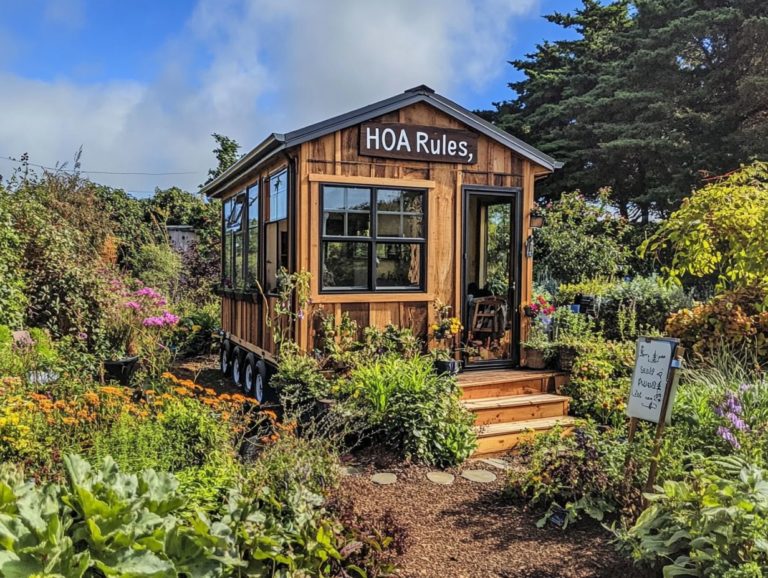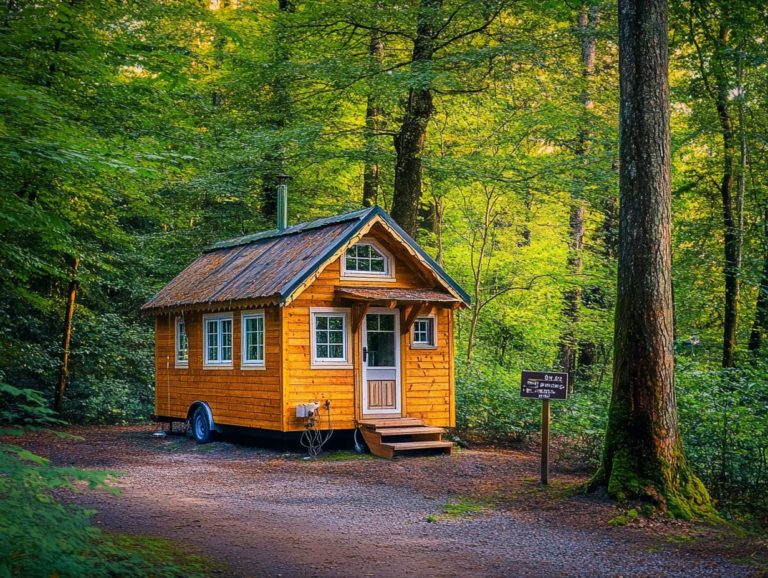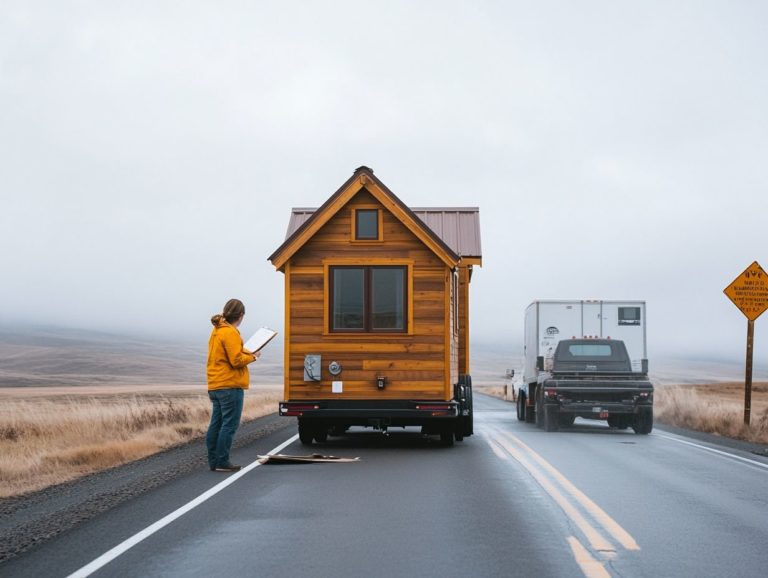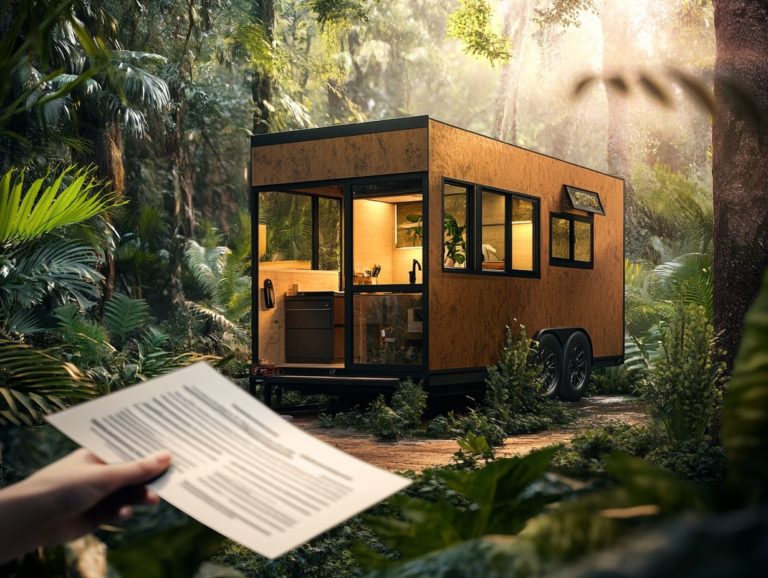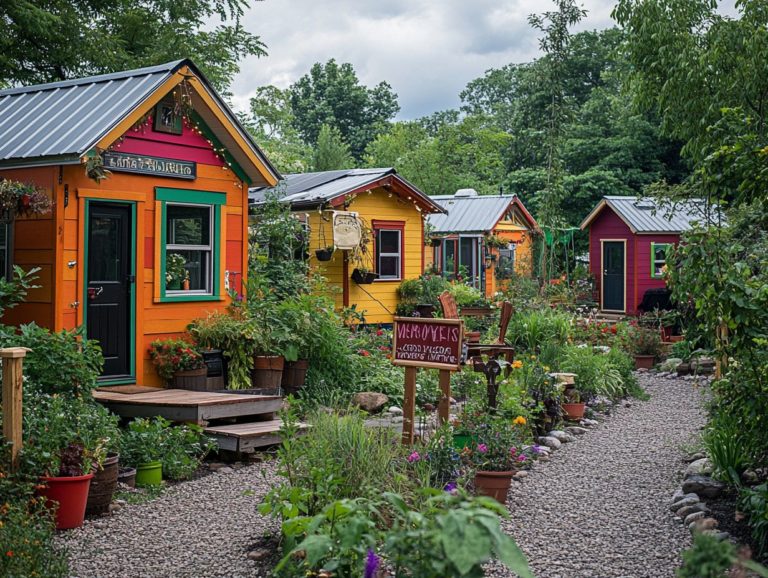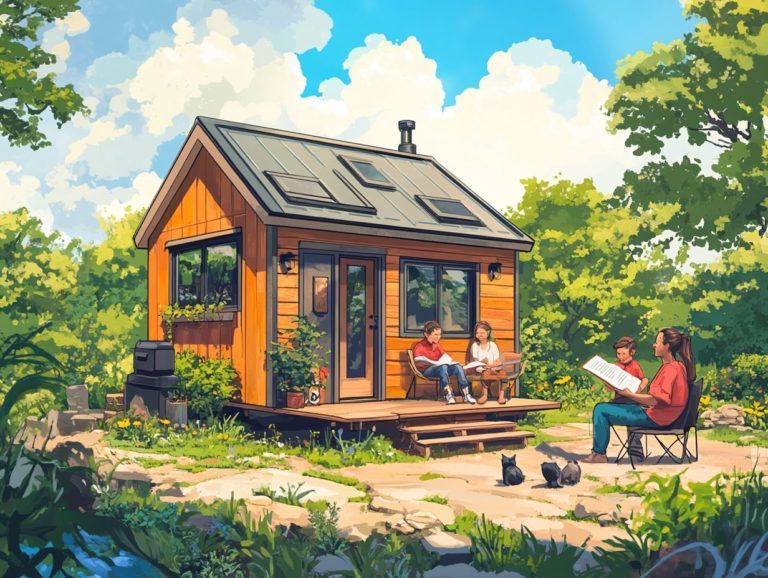Tiny House Construction: What Are the Legalities?
Tiny houses have emerged as a sought-after choice for those pursuing a minimalist lifestyle. They provide not only financial freedom but also a uniquely enriching living experience.
Beginning the process of tiny house construction means you need to navigate a complex landscape of legal considerations, including zoning laws, building codes, permits, and various regulations.
This guide helps you understand the essential steps of designing and building your tiny home, examining financing options, and weighing the pros and cons of tiny house living.
Whether you re an aspiring homeowner or simply intrigued by this trend, you ll uncover valuable insights to support you on your tiny house adventure. Start your tiny house journey today!
Contents [hide]
- Key Takeaways:
- Legal Considerations for Tiny House Construction
- Building a Tiny House: Step-by-Step Guide
- Financing Options for Tiny House Construction
- Living in a Tiny House: Pros and Cons
- Frequently Asked Questions
- What are the legal requirements for constructing a tiny house?
- Do I need to obtain a building permit for my tiny house?
- Can I park my tiny house anywhere?
- What type of foundation can I use for my tiny house?
- Are there any size limitations for a tiny house?
- What are the potential consequences of not following legal requirements for tiny house construction?
Key Takeaways:
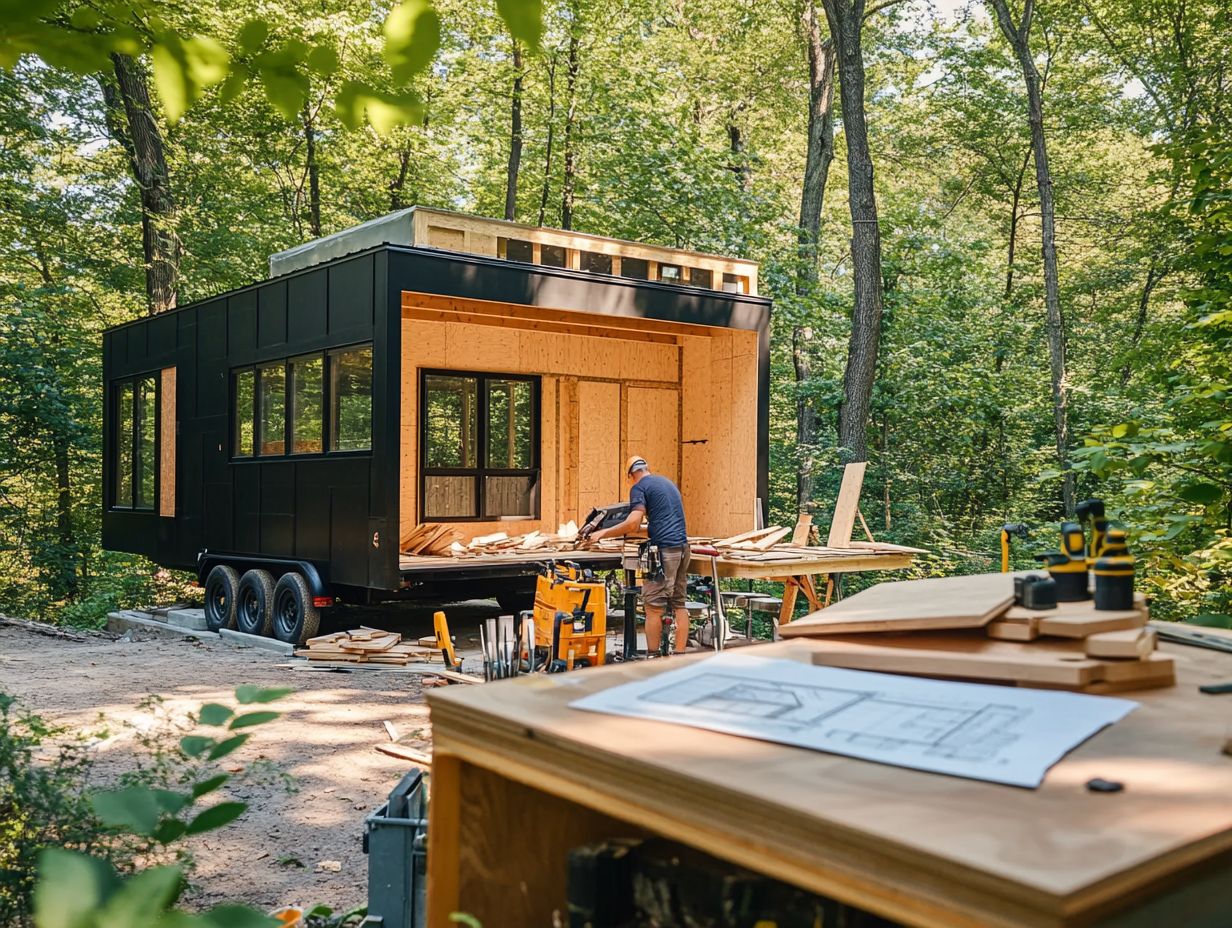
- Research and comply with local zoning and building codes before starting construction on a tiny house to avoid legal issues.
- Obtain necessary permits and follow regulations to ensure a safe and legal tiny house.
- Consider all costs and budgeting options, including alternative funding sources, when planning for tiny house construction.
What is a Tiny House?
A tiny house is your gateway to a compact dwelling that champions a minimalist lifestyle, typically spanning 100 to 400 square feet. This distinctive approach to homeownership attracts those who seek affordable housing solutions and enhanced mobility. It embodies the principles of the tiny house movement, advocating for smaller living spaces to simplify life. Whether you opt for a tiny home on a solid foundation or a movable version on wheels, you gain the flexibility and adaptability to suit various living situations.
These dwellings feature clever space-saving designs, including multifunctional furniture and innovative storage solutions that maximize every square inch. With styles ranging from rustic and contemporary to cutting-edge and eco-friendly, there s a tiny home to match your unique taste and needs.
The appeal of tiny living captivates many with its unique charm, especially in tiny house communities. Here, you can connect with like-minded individuals, share resources, and cultivate a genuine sense of belonging. However, navigating zoning regulations can be tricky, as they vary from state to state and can impact where you place your tiny home. For those considering this lifestyle, understanding tiny house occupancy permits is essential. States like California, Texas, and Florida are particularly welcoming to tiny homes, each offering unique designs that reflect local culture and climate, making them attractive options for those looking to live simply yet stylishly.
Legal Considerations for Tiny House Construction
When contemplating the construction of a tiny house, you must adeptly navigate a myriad of legal considerations. These include tiny house laws and building codes that differ significantly from state to state.
In states like California, Florida, and Texas, the legal landscape surrounding tiny homes can profoundly influence the practicality of tiny house living. For a comprehensive understanding, refer to tiny house regulations: a state-by-state guide on adhering to local regulations, including securing the requisite tiny house permits, which is crucial to ensure your tiny home is both legally compliant and safe for habitation.
Zoning and Building Codes
Zoning and building codes are pivotal to your tiny house construction journey, guiding where and how you can build according to local ordinances. It s crucial for you to grasp the specific zoning regulations that govern tiny home communities or movable tiny houses. These regulations often dictate minimum square footage, setbacks (the required distance from property lines), and utility requirements. By ensuring compliance with building codes like those outlined by the California State Building Code and the American National Standards Institute you can secure the safety and quality of your tiny house.
Take California, for example. Many municipalities have embraced relaxed zoning laws to meet the rising demand for tiny homes, allowing you to position your home within established communities or on private properties. However, it’s important to be aware of specific regulations, such as tiny house HOA rules. Texas often permits tiny homes as accessory dwelling units (ADUs), which significantly expands your housing options.
These regulations can greatly influence your choices regarding where to build, how to design your home, and whether you can establish a permanent residence or prefer the freedom of mobility. Understanding these nuances is key to making your tiny home dreams a reality! By engaging with planning departments, you’ll equip yourself with the insights needed to navigate these intricate regulatory environments with confidence.
Permits and Regulations
Obtaining the right permits is a crucial step in your tiny house construction journey, as you must meet various legal requirements to ensure compliance with local and state regulations. Tiny house permits can vary significantly based on location, so understanding the specific permits needed in areas like California is essential. The California Department of Housing and Community Development plays a pivotal role in overseeing these requirements. Your knowledge of zoning regulations is vital for successfully navigating the permitting process.
In Florida, for instance, you ll need to consider building permits, zoning regulations, and even specific codes related to environmental impact. Conversely, if you find yourself in New York, be prepared to tackle various permits, which may include site plan reviews and adherence to the New York State Uniform Fire Prevention and Building Code.
When applying for these permits, you typically need to submit detailed plans of your intended structure. This often means working closely with local planning boards or departments. Understanding these nuances not only helps streamline your applications but also ensures that your tiny home is constructed sustainably and in alignment with local guidelines. If you need further guidance, consider seeking tiny house legal assistance to find help.
Building a Tiny House: Step-by-Step Guide
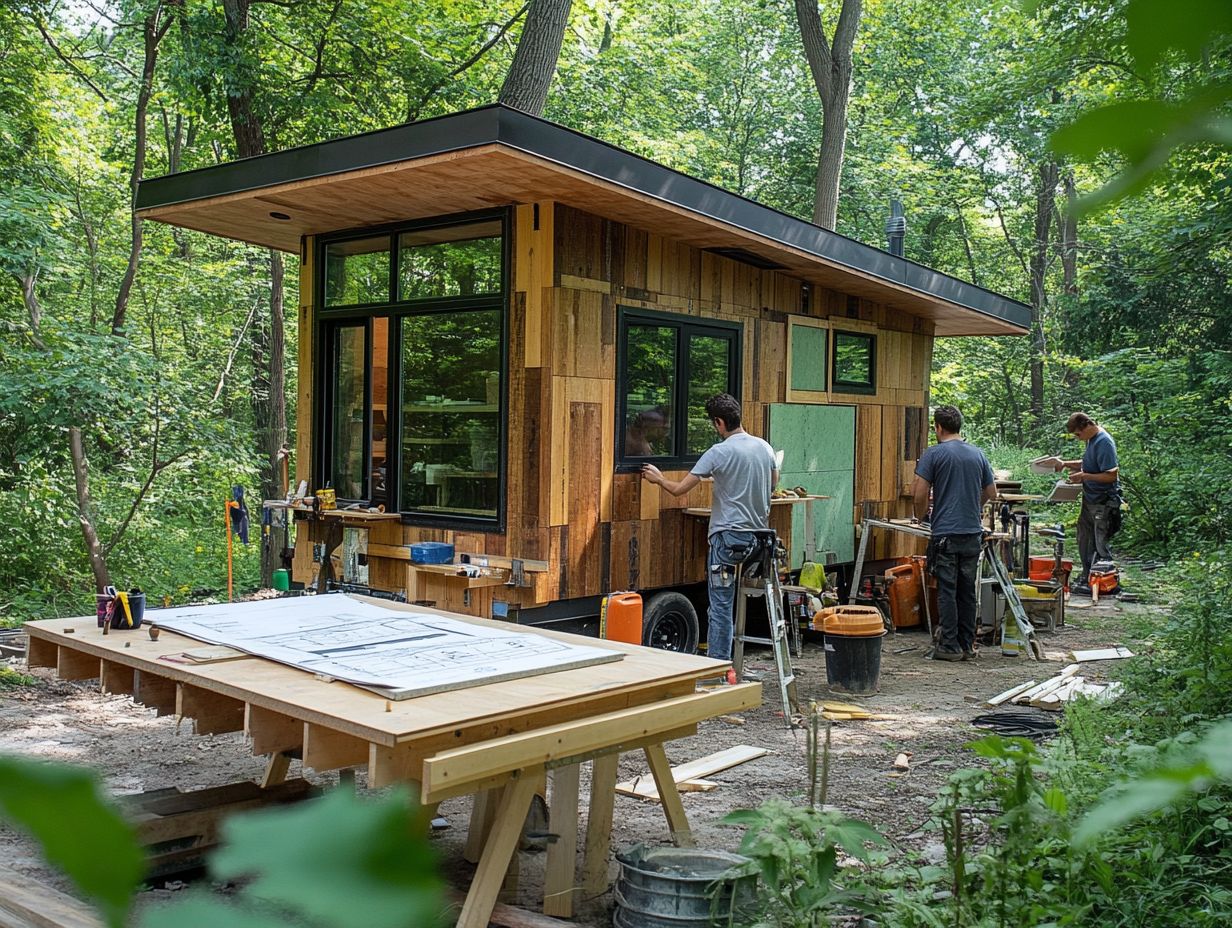
Building a tiny house requires a detailed, step-by-step approach that encompasses everything from your initial design and planning to the selection of materials and construction techniques. This journey can be customized to craft accessible tiny homes that cater to diverse lifestyles, underscoring the significance of maximizing space and utilizing sustainable materials.
As the tiny house movement gains momentum, grasping the intricacies of tiny house construction becomes essential for those aspiring to build or own their own compact haven. Understanding tiny house zoning laws is also crucial in this journey.
Design and Planning
Proper design and planning are essential for you to create an effective tiny house, focusing on maximizing the layout and ensuring that every inch of space is used efficiently. Tiny house design often calls for innovative solutions to incorporate essential amenities while maintaining a comfortable living environment. By thoughtfully considering the layout and functionality of each component, you can craft tiny living spaces that cater to your unique needs and those of your family.
Exploring various design approaches can significantly enhance your overall experience of tiny house living. For instance, think about utilizing multifunctional furniture that allows you to transform your space effortlessly imagine a sofa that converts into a bed or a dining table that folds away when not in use!
Clever planning strategies, such as vertical storage and open shelving, can help you eliminate clutter and make the most of your limited square footage. By integrating these innovative space-saving techniques into your design, your tiny home will not only become more practical but will also reflect your personal style, creating a cozy and inviting atmosphere.
Ready to start your tiny house adventure? Research your local regulations today and connect with builders who can help you turn your dream into reality! Understanding the importance of zoning is crucial in this process.
Materials and Construction Techniques
When you’re constructing a tiny house, selecting the right materials and employing effective construction techniques is crucial for achieving both durability and sustainability. Many builders find themselves drawn to environmentally friendly materials that not only reduce environmental impact but also elevate the aesthetics of tiny homes.
Familiarizing yourself with different construction methods whether it s modular building or traditional framing can significantly enhance the overall quality and efficiency of your tiny house project.
For example, reclaimed wood and bamboo have gained popularity for their low carbon footprints and natural charm. Opting for insulation materials like straw bales or recycled denim can boost energy efficiency while cutting down on waste.
Choosing advanced construction methods, such as structural insulated panels (SIPs) a type of building panel that provides insulation and structural support can yield a stronger, more energy-efficient structure. By prioritizing sustainable practices throughout the building process, you cultivate a healthy living environment and ensure that your tiny house stands the test of time. This makes it an ideal choice for eco-conscious individuals looking to downsize.
Financing Options for Tiny House Construction
Exploring financing options for tiny house construction is essential for anyone looking to embark on the journey of tiny home living. Cost and budgeting are key players in this endeavor.
As the popularity of tiny homes as affordable housing solutions continues to rise, a range of financing avenues has emerged. These include personal loans, RV loans, and specialized tiny house mortgages. To navigate this trend effectively, it’s crucial to understand tiny house laws and grasp the unique financial landscape surrounding tiny house construction to make informed and confident decisions.
Costs and Budgeting
Understanding the costs is crucial for your tiny house dream don’t wait! Overall expenses can vary significantly based on factors like size, materials, and location, making it vital to create a detailed budget capturing all potential costs.
By meticulously accounting for every element of construction and living, you can navigate the financial landscape of tiny home living with greater ease.
As you embark on this journey, consider various costs, such as land prices, which can fluctuate dramatically based on geographic preferences and zoning regulations. The choice of materials is another major factor; while eco-friendly options may carry a higher upfront cost, they often provide long-term savings and sustainability benefits.
Labor costs also play a crucial role in your planning. Whether you hire professionals or take the DIY route, understanding these financial commitments is key. Tips like prioritizing essential features and sourcing reclaimed materials can lead to substantial savings, helping you maintain a feasible budget while pursuing your dream of tiny home ownership.
Alternative Funding Sources
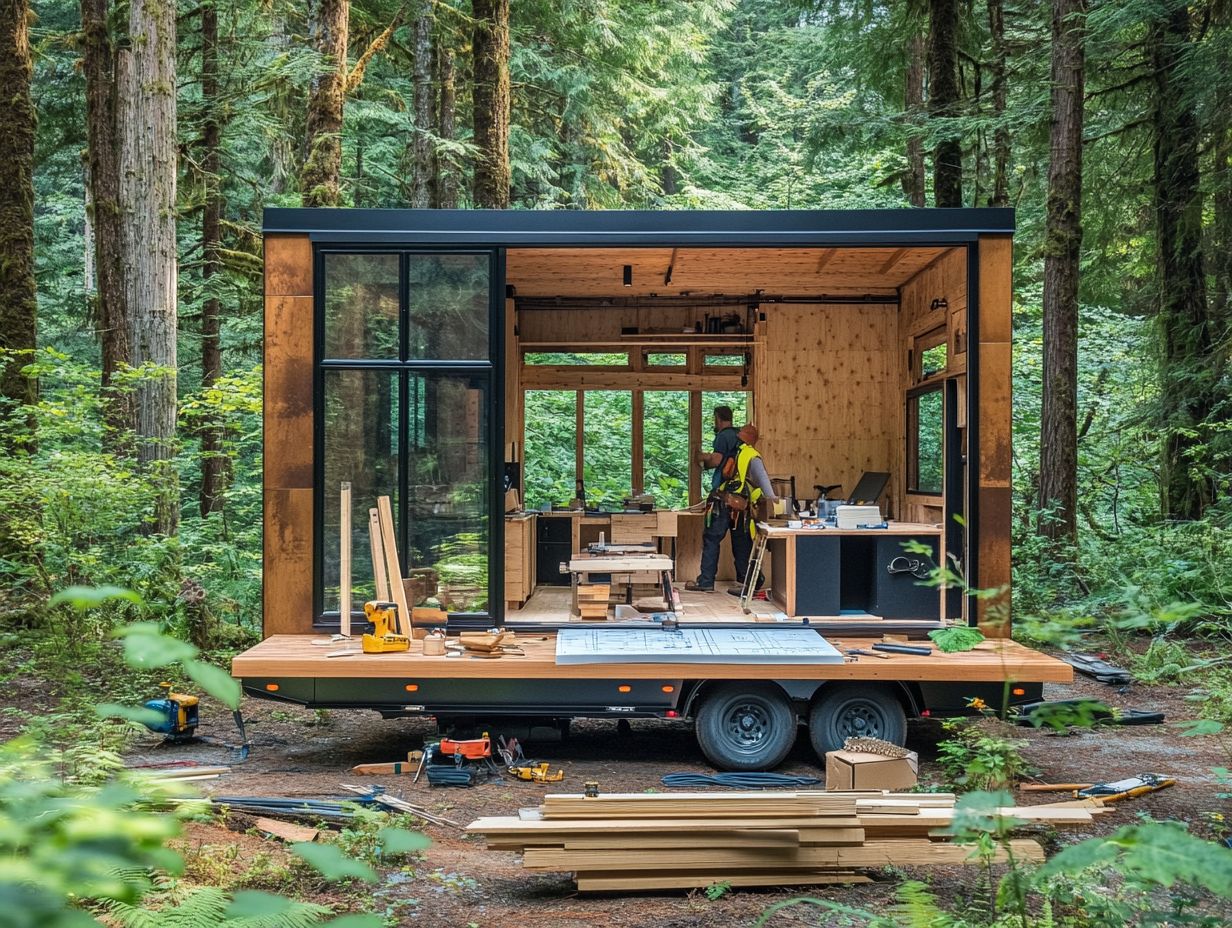
Exploring alternative funding sources opens up a world of possibilities for aspiring tiny house builders. These options go beyond traditional financing methods. Crowdfunding, grants, and community resources are innovative alternatives for financing tiny house construction.
Consider tapping into crowdfunding platforms like GoFundMe or Indiegogo. They provide a stage for you to share your story and connect with supporters who resonate with your vision. For instance, a couple successfully funded their eco-friendly tiny home project by passionately presenting their mission and design to potential backers.
Grants from organizations such as Habitat for Humanity or local housing authorities specifically target affordable housing initiatives, offering financial assistance for those eager to embark on such projects. These success stories showcase the potential of alternative funding and inspire you to explore these opportunities. Ultimately, this nurtures a community dedicated to sustainable living and innovative housing solutions.
Start planning your tiny home today and explore these options!
Living in a Tiny House: Pros and Cons
Choosing to live in a tiny house presents a distinctive blend of advantages and challenges. This makes it crucial for anyone considering this lifestyle shift.
Proponents of tiny home living emphasize the perks of lower expenses, embracing minimalism, and fostering a more sustainable way of life. However, it’s important to recognize potential hurdles, such as limited space and rules about where you can place your tiny house, including understanding tiny house land use laws, which can be significant concerns for those starting their journey into tiny living.
Benefits of Tiny House Living
The benefits of tiny house living extend beyond merely saving money; they introduce you to a sustainable and minimalist lifestyle that many find irresistibly appealing. Embracing tiny home living often means experiencing a reduced environmental impact, lower utility costs, and the chance to lead a more intentional life.
These advantages are not just appealing; they can transform your life! By downsizing to a smaller space, you may uncover the joy of decluttering, resulting in a more organized and less stressful living environment.
Financially, as a tiny house dweller, you save on mortgage payments and cut down on costs related to insurance and maintenance. This newfound financial freedom can open doors for you to invest in personal growth, travel, or further education.
Tiny homes usually consume fewer resources, leading to a smaller carbon footprint while promoting sustainable practices like rainwater harvesting and solar energy utilization. Ultimately, transitioning to a tiny house often nurtures a sense of community as you engage more deeply with your surroundings and neighbors.
Challenges and Considerations
While the allure of living in a tiny house may capture your imagination, several challenges and considerations demand your attention before taking the plunge. Space limitations can be significant obstacles, requiring a shift towards a lifestyle that prioritizes simplicity and organization.
As you navigate zoning issues and legal requirements, it’s crucial to conduct thorough research, including understanding tiny house financing, to ensure a smooth planning process. Embracing a minimalist lifestyle entails a profound psychological shift that may not come easily. You’ll need to learn how to part with sentimental belongings and reconsider your consumption habits.
This often leads to a transformative journey that emphasizes valuing experiences over material possessions. The social dynamics of tiny house living are equally important. Whether you choose to live solo or within a community, understanding how to share resources and space is essential.
This often means honing new communication skills and building strong connections in close quarters, making your transition both a personal and communal endeavor.
Frequently Asked Questions
Here are some common questions about tiny house living.
What are the legal requirements for constructing a tiny house?
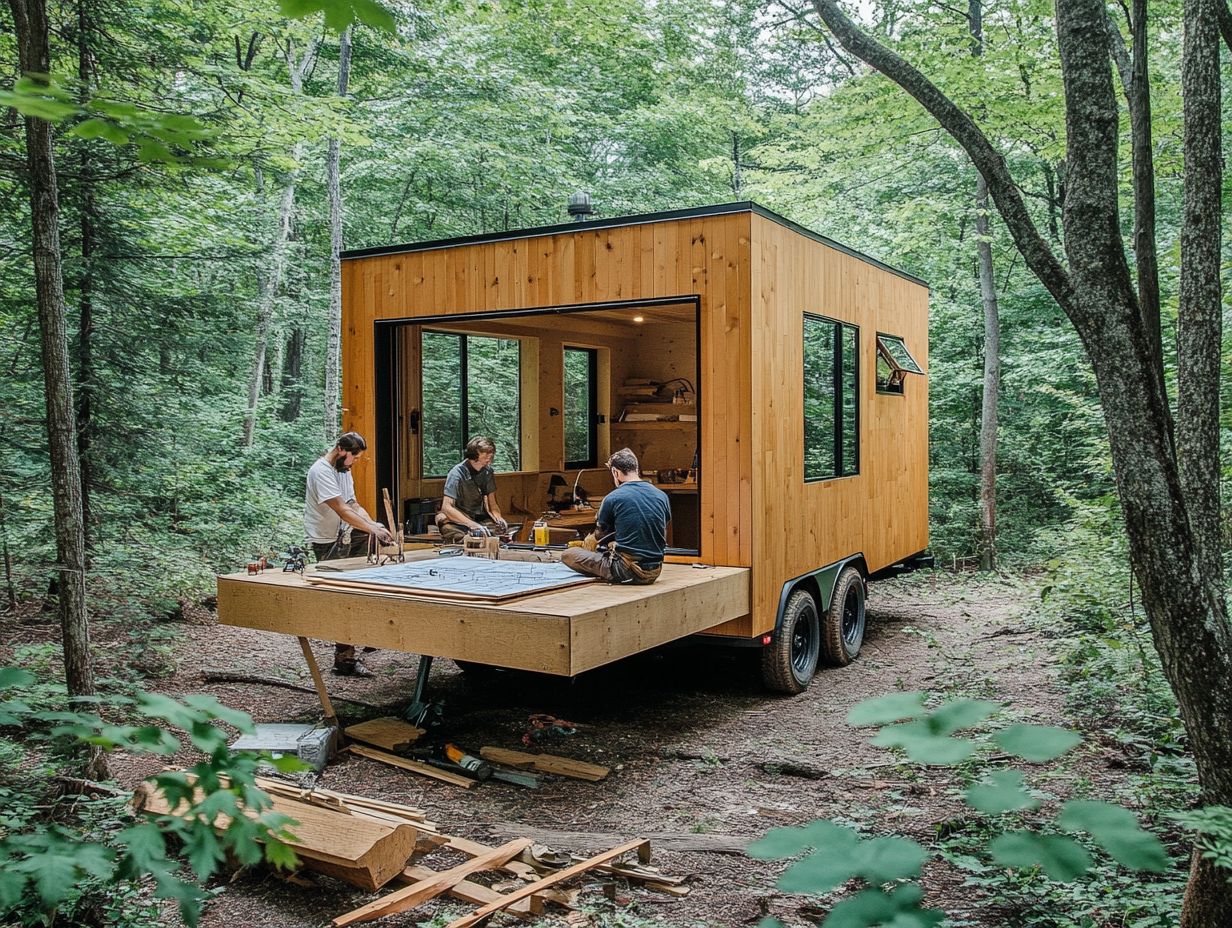
The legal requirements for constructing a tiny house vary depending on your location. It s important to research and understand zoning laws, building codes, and permits before beginning construction.
Do I need to obtain a building permit for my tiny house?
In most cases, yes. Building codes and regulations typically require a permit for any structure, including tiny houses, that meets certain size and occupancy criteria. It s important to check with your local government to determine the specific requirements in your area.
Can I park my tiny house anywhere?
No, you cannot park your tiny house just anywhere. Zoning laws and regulations dictate where you can park and live in a tiny house. Some areas allow tiny houses to be parked on private property as long as certain requirements are met, while other areas only allow tiny houses in designated communities.
Ready to take the leap? Discover how tiny living can change your life today!
What type of foundation can I use for my tiny house?
Your tiny house foundation choice depends on local building codes. Common options are permanent foundations, skids, or wheels. Research your local guidelines before choosing a foundation.
Are there any size limitations for a tiny house?
Absolutely! Tiny houses often face size limits set by local zoning laws, which are rules that determine land use. These limits can differ based on whether your tiny house is on wheels or a permanent foundation. Do your research to ensure success!
What are the potential consequences of not following legal requirements for tiny house construction?
If you ignore legal requirements for tiny house construction, you might face fines or legal action, or even forced removal of your tiny house. Follow all laws to prevent penalties.

